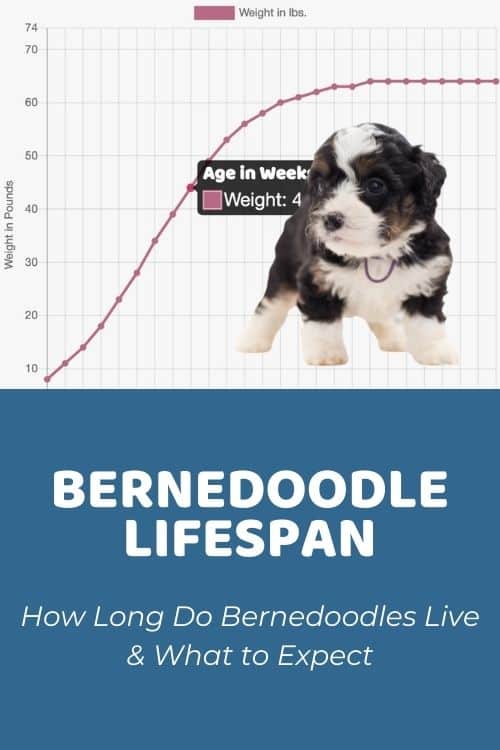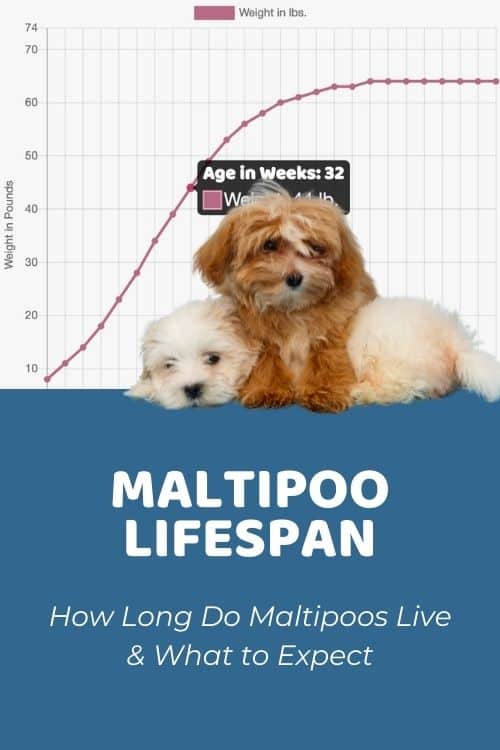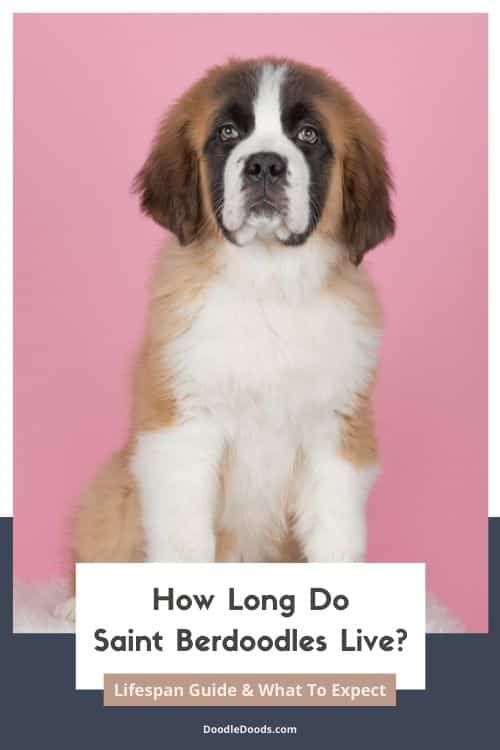A dreaded question that many dog owners and future dog owners have to face at one point or another is – how long do labradoodles live? In this article, we’ll discuss everything about the Labradoodle lifespan, their life stages, and what you can do to keep your Dood healthy and happy for as long as possible. Let’s dive in!
Labradoodle Lifespan: How Long Do Labradoodles Live?
Labradoodles are usually very healthy dogs with a fairly long life, especially compared to some other breeds. The average Labradoodle lifespan is around 12 to 15 years. What’s great about Doodles and all cross-breeds is that they benefit from hybrid vigor, which indicates better, optimal health.
Hybrid vigor means that a cross-breed dog has a smaller chance of inheriting common genetic illnesses that run in the parental breeds. As you might know, Labradoodles inherit the best of both worlds – the low-shedding Poodle coat, high intelligence levels from both parents, and the adorable Labrador Retriever personality.
However, this also goes for their health, as Labradoodles are usually considered healthier than their purebred parents. Thanks to selective breeding, it’s possible to breed together two dogs with superior qualities, both in terms of temperament, looks, and health.
As a result, the lifespan of a Labradoodle is often longer than the Labrador Retriever’s as well. For instance, the average lifespan of a Labrador Retriever is 10 to 12 years, whereas the Poodle lifespan is 12 to 15 years.
It’s worth mentioning that hybrid vigor is most prevalent in first-generation, or F1 Labradoodles, and it starts to diminish with each consecutive generation. Nonetheless, ethical Doodle breeders conduct rigorous health and genetic testing on their breeding dogs to minimize the risk of puppies inheriting any faulty genes or hereditary conditions.
Labradoodle Lifespan: How Their Generation Can Play A Role
When it comes to Labradoodle lifespan, their generation is also something to take into consideration. As you may know, there are many different ways we can breed a litter of Labradoodles. We have the OG F1 Labradoodles, then there are second-generation Labradoodles, not to mention all the backcrosses and backcross backcrosses.
But what does it all mean exactly and why is that important? First of all, generations tell us how a litter of Labradoodles was bred – this means that we know exactly which parents were used in the mix, either purebred Labradors and Poodles, or even Labradoodles and Poodles.
Secondly, generations give us a rough estimate about the puppies’ genetic makeup, helping us gain a better understanding of how they might turn out. This includes their appearance, potential for shedding, coat type, and even a hint of their life expectancy. Of course, a Labradoodle’s generation won’t give us a definitive answer to the exact genetics that are at play, but it does get us a little bit closer to predicting the outcome.
| 1st Parent | 2nd Parent | % Labrador Retriever* | % Poodle* | |
| F1 Labradoodle (first-generation) | Labrador Retriever | Poodle | 50% | 50% |
| F1b Labradoodle (first-generation backcross) | F1 Labradoodle | Poodle | 25% | 75% |
| F1bb Labradoodle (first-generation backcross backcross) | F1b Labradoodle | Poodle | 12.5% | 87.5% |
| F2 Labradoodle (second-generation) | F1 Labradoodle | F1 Labradoodle | 50% | 50% |
| F2b Labradoodle (second-generation backcross) | F1 Labradoodle | F1b Labradoodle | 37.5% | 62.5% |
| F2b Labradoodle (alternate cross) | F2 Labradoodle | Poodle | 25% | 75% |
| F3 / Multigen Labradoodle | F1b Labradoodle or higher | F1b Labradoodle or higher | Varies | Varies |
*These are generic calculations only – genetics are rarely mathematically accurate.

F1 Labradoodle Lifespan
A first-generation or F1 Labradoodle has a 50-50 mix of both the Labrador Retriever and the Poodle. As it can be difficult to predict the traits of F1 Labradoodles, their lifespan can range anywhere from 12 to 15 years on average, depending on which genes are more dominant.
However, as F1 Labradoodles are most commonly bred as standard-sized pups, we can assume that their life expectancy will fall on the lower end of the scale. That’s because larger dogs usually live slightly shorter lives when compared to smaller Doods.
On the other hand, F1 Labradoodles tend to benefit most from hybrid vigor, which means that they’re less likely to inherit genetic conditions and overall benefit from healthier lives.
F1b Labradoodle Lifespan
F1b Labradoodles or first-generation backcross Labradoodles are bred by crossing an F1 Labradoodle back to a Poodle. This will make their rough genetic makeup about 25% Labrador Retriever and 75% Poodle.
As the Poodle’s average lifespan ranges between 12 to 15 years compared to the 10 to 12 years of the Labrador Retriever’s, we can expect these pups to take more after the Poodle parent, falling somewhere on the higher end of the scale.
In addition to that, smaller Mini Labradoodles are often bred as backcross generations, so we can expect them to live longer as well – about 13 to 15 years on average.
F1bb Labradoodle Lifespan
F1bb or first-generation backcross backcross Labradoodles are created by crossing an F1b Labradoodle back to a Poodle. This means that they have an even higher percentage of the Poodle in their genetic makeup – about 87.5%. Roughly, of course.
Therefore, we can expect the average Labradoodle lifespan in the F1bb generation to also lean more on the Poodle’s side. However, these pups may benefit less from hybrid vigor, making them more susceptible to genetic conditions that are common in purebred Poodles.
F2 Labradoodle Lifespan
F2 Labradoodles, also known as second-generation Labradoodles again have roughly 50% Poodle and 50% Labrador Retriever in their genetic makeup. These Doods are created by crossing an F1 Labradoodle to another F1 Labradoodle. And although their genetic makeup is seemingly similar to F1 Labradoodles, F2 Labradoodles tend to come from carefully chosen F1 Labradoodles. This way, breeders have slightly more control over the outcome.
One thing to note with F2 Labradoodles is that hybrid vigor usually isn’t as pronounced with these Doods when compared to F1 Labradoodles. So, it all comes down to the puppy parents’ genetics and what traits are passed onto the offspring.
F2b Labradoodle Lifespan
As we learned from the generation comparison chart above, there are two different ways to breed F2b Labradoodles. We can either cross an F1 Labradoodle with an F1b Labradoodle, or instead cross an F2 Labradoodle back to a Poodle.
The former results in a rough genetic makeup of 37.5% Labrador Retriever and 62.5% Poodle. The latter results in a similar genetic makeup to F1b Labradoodles with about 25% Labrador Retriever and 75% Poodle.
As both of these F2b Labradoodle variations have a higher percentage of Poodle than Labrador Retriever in their genetic makeup, we can expect them to also take more after the Poodle’s average 12 to 15 year lifespan.
Nonetheless, it all boils down to each puppy’s unique genetics and even size. Therefore, we can expect smaller F2b Mini Labradoodles to live longer, about 13 to 15 years on average.
Life Stages Of A Labradoodle
Like other dogs, Labradoodles experience different stages of life from birth to their last years. Let’s take a closer look at the life stages of a Labradoodle.
Puppyhood (0-6 months)
Puppyhood starts from the moment your dog is born and usually lasts until they reach sexual maturity. During this life stage, your puppy is very vulnerable to pretty much everything. So, it’s especially important you stay on top of your puppy’s vaccination schedule and feed them specially formulated puppy food. Oh, and they tend to sleep a lot, as well.
You should already be training and socializing your pup already at this life stage. Introduce grooming, basic manners, and keep up with house training and crate training. You should also introduce your puppy to other dogs, but only once they’re fully vaccinated.
Adolescence (6-18 months)
Adolescence starts when your puppy reaches its sexual maturity. Once this happens, you should consult with your veterinarian about spaying or neutering your puppy. Both male and female dogs can exhibit unwanted behaviors while in heat. For instance, male pups are especially prone to marking with urine. In addition to that, spaying or neutering at an appropriate age has shown to have many benefits for their health and behavioral development.
Although at this stage your Dood likely still looks like a puppy, it’s likely that they’ve already experienced all the growth spurts and their growth will start to gradually slow down after 6 months of age.
During the adolescence period, your puppy probably acts like an actual teenager. It’s no surprise that this life stage is often called the hellion stage. You might notice that your pup has suddenly forgotten all of its training and just bluntly ignores all of your cues. Don’t worry, stay consistent and firm, and this will pass soon enough.
Adulthood (1-10 years)
A Labradoodle enters adulthood once they’re fully-grown. This typically happens between their first and second birthday, depending on their size.
A general rule of thumb is that smaller, Mini Labradoodles finish growing sooner, sometime around their first birthday. Larger, Standard Labradoodles typically take more time and finish growing somewhere around 18 to 24 months of age.
Typically, dogs reach their full adult height sooner than they reach their full weight. This usually happens around 10 to 12 months of age. After that, they will then continue to gain some more weight and fill out until they reach full maturity. However, once they’re there, you should make sure that your puppy doesn’t keep putting on weight every month, as this might indicate that you’re overfeeding your pup. Of course, this can lead to obesity, which can affect your Labradoodle’s lifespan.
Now that your pup is no longer a puppy, they’ve probably calmed down a bit and actually behave according to their size as well. If you’ve done all the work in puppyhood and adolescence, your Dood knows how to socialize with people and other dogs, how to behave, and go potty.
Senior (10+ years)
The golden years of a Labradoodle’s lifespan are here. Dogs above the age of 10 are generally considered seniors. However, your pup might start slowing down a bit and showing first signs of aging starting from 7 years of age.
Senior dogs are usually less active, they usually need a bit less food, and overall they have a calmer disposition. Once your dog is a senior, you should take them to regular vet check-ups every 6 months to keep a close eye on their health. This can greatly increase your Labradoodle’s lifespan and improve their quality of life in those beautiful golden years.
Labradoodle Aging Signs
Although this is something that no dog owner ever wants to think about, at some point you have to face that your pup is entering its senior years and might start showing signs of aging. Most commonly, you’ll notice that they aren’t as active as they used to be, and their movement has slowed down a bit. Older dogs generally become less active, but it can also be due to joint problems. Of course, this often leads to increased weight or even obesity.
Other telltale signs of aging are vision problems and loss of sight, often accompanied with cloudy eyes. In addition to that, you might notice lumps and bumps under the skin, bad breath and dental problems, loss of hearing, or that your pup needs to go potty more frequently.
Behavioral signs of your Dood aging include forgetfulness, confusion, fear of familiar people, objects, or places, anxiety, or compulsive behaviors. Those mental signs of aging are sometimes caused by canine cognitive dysfunction syndrome, which is similar to Alzheimer’s in humans.
Extending The Lifespan Of A Labradoodle
Proper Diet
Diet is one of the most important factors that can affect a Labradoodle’s lifespan. You should feed your Dood a high quality and balanced diet. In this guide we share the top brands for both Labradoodle puppies and adults that Doodle owners and breeders recommend.
Equally important is to not over or underfeed your dog. Did you know that the lifespan of a Labradoodle who is obese can be as much as 2 years less than for pups who are in healthy weight?
In addition to that, excess weight can contribute to joint problems like hip and elbow dysplasia, or even lead to diabetes and other heart problems. For this reason, it’s crucial you feed your Labradoodle the exact amount of calories they need, every single day.
Exercise
Similarly to a good diet, a proper exercise regimen can drastically extend the lifespan of a Labradoodle. Exercise greatly benefits the joints and metabolism, but also keeps your dog’s heart healthy. As Labradoodles are active dogs, it’s crucial you provide your pup what it needs to thrive.
Take your pup on daily walks, let them run and swim, spend some time playing with them, and provide them plenty of mental stimulation. This will keep your pup in top shape both mentally and physically much longer.
In fact, not only does exercise extend your Labradoodle’s lifespan, it can also keep any unwanted behaviors at bay. For example, bored Doods can become anxious and destructive. Likewise, you’ll want to make sure that you’re keeping up with all the training, as it’s crucial for your pup’s development and confidence.
Grooming
Like other Doodles, Labradoodles are pretty high maintenance when it comes to their coat care. They’re prone to matting, so staying on top of your Dood’s grooming routine is essential. Make sure you brush your Labradoodle daily, clean their ears on a regular basis, give them a thorough wash once in a while, and trim their hair.
Grooming isn’t just about vanity. Although unkempt hair does not look cute by any means, mats can actually cause your dog some serious discomfort and pain. It can also lead to skin irritations and infections.
Similarly, you’ll want to trim the hairs inside the ears, as they tend to grow very long. The hair inside the ears can trap in excess moisture and bacteria, which often results in painful ear infections.
Keeping An Eye On Your Dog’s Health
From the day you bring your new puppy home, you should always keep an eye on your dog’s health. In puppyhood, you’ll likely have to visit the vet for vaccines, then for spaying or neutering, and later on to stay up to date with vaccinations and to make sure there are no sudden changes in their health.
The first signs of underlying health issues aren’t always exactly visible, but you can figure out if anything is wrong by paying close attention to your dog’s behavior and changes in routine. For instance, does your dog eat less? Are they suddenly pacing around or whining a lot? Are they experiencing changes in bowel movements or bathroom habits? Do they have a difficult time standing up or going up the stairs?
Although Labradoodles are usually considered healthier than their purebred parents, they are still prone to some diseases. The most common health issues in Labradoodles include:
- Joint problems, such as hip and elbow dysplasia, patellar luxation, and cruciate ligament damage
- Vision problems and eye diseases like progressive retinal atrophy (PRA), retinal dysplasia, and cataracts
- Ear infections and otitis
- Skin allergies and food allergies
- Gastrointestinal issues and food intolerances
- Hormonal diseases, such as hypothyroidism, hyperthyroidism, or Addison’s disease
- Certain types of cancer, typically over the age of 10
For this reason, it’s especially important you take your pup to regular vet check-ups. This is the best way to keep track of your dog’s health, quickly discover any underlying health conditions, and thus extend your Labradoodle’s lifespan and increase their quality of life.
Labradoodle Lifespan: Frequently Asked Questions
What Is The Average Lifespan For A Labradoodle? How Long Do Labradoodles Live?
The average Labradoodle lifespan ranges between 12 to 15 years. That’s considerably more than the lifespan of a Labrador Retriever. Nevertheless, it’s crucial that you provide your pup a healthy diet, plenty of exercise, keep up with their grooming routine, and regularly visit the vet to make sure your Dood lives the healthiest and thus longest life possible.
What Health Issues Do Labradoodles Have?
Even though Labradoodles have a smaller chance of inheriting hereditary illnesses that are most common in the parental breeds, they are still at a risk of certain health problems. These include hip and elbow dysplasia, cruciate ligament damage, eye diseases and vision problems like PRA, cataracts, and retinal dysplasia.
Other common health issues in Labradoodles are all sorts of allergies and sensitivities, such as skin and food allergies. They are also prone to ear infections and they might develop certain types of cancer at some point, typically later on in life.
Is 13 Old For A Labradoodle?
13-year old Labradoodles are considered senior dogs and they often show signs of aging. However, with a proper diet, good exercise regimen, regular vet check-ups, and lots of love, you’ll be able to keep your Dood in the best shape possible during his golden years.
What’s The Lifespan Of A Mini Labradoodle?
The typical Labradoodle lifespan is 12 to 15 years. Although Mini Labradoodles have the same life expectancy, they tend to live longer than their standard-sized counterparts. That’s because smaller dogs generally live longer than larger dogs.
Labradoodle Lifespan: Final Thoughts
In conclusion, all Doodles are typically in good health and greatly benefit from hybrid vigor, especially if you’ve adopted your puppy from a reputable breeder that has thoroughly tested the breeding dogs for various genetic conditions. Nevertheless, it’s your responsibility to make sure that your pup eats a healthy and balanced diet, gets enough mental and physical stimulation, and overall thrives in your household. After all, your Labradoodle’s lifespan is very much influenced by your pup’s lifestyle.
Learn How to Care for Your Doodle Puppy!

Perfect for first-time Doodle parents, get ALL your questions answered, including questions new Doodle parents don’t even think to ask.
Plus, get $700 worth of Bonus Materials for FREE, including:- Doodle Parenthood Community and Support Group ($190 value)
- Doodle Puppy Growth Tracker ($20 value)
- EMERGENCY Cheatsheet: When To Call The Vet Immediately ($50 value)
- HELP! Button ($145 value)
- And SO MUCH MORE!
The information on this page is for informational purposes only. It is not intended to be a substitute for qualified professional veterinary advice, diagnosis, or treatment. Always seek the advice of your veterinarian or other qualified animal health provider with any questions you may have.












